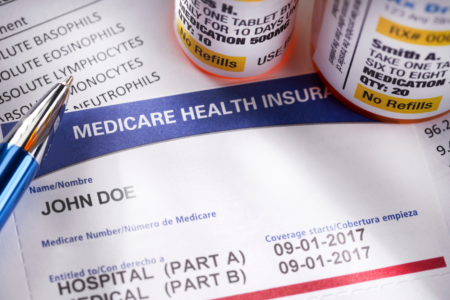
What Is Medicare Part D? A Smart Guide to 2025 Prescription Drug Coverage
Back to Medicare FAQsIf you’re new to Medicare or preparing for retirement, you’ve likely asked yourself: What is Medicare Part D, and do I need it? Understanding how Part D works is one of the most important steps you can take to protect your health—and your wallet.
Medicare Part D is your prescription drug coverage. It helps pay for the medications you use regularly and protects you from high out-of-pocket costs. But not all Part D plans are the same, and coverage details can be confusing.
Prescription drug coverage is a critical part of staying healthy as you age—and without the right plan, even common medications can become unaffordable. That’s why understanding what Medicare Part D is and how it works in 2025 is more important than ever. With recent changes aimed at lowering drug costs, learning what is Medicare Part D can help you make confident choices and avoid surprises at the pharmacy.
What Is Medicare Part D?
What is Medicare Part D? It’s the part of Medicare that helps cover the cost of prescription medications through private insurance companies approved by Medicare. It was introduced in 2006 as part of the Medicare Modernization Act and is available to anyone enrolled in Medicare Part A and/or Part B.
You can get Medicare Part D coverage in one of two ways:
-
By enrolling in a standalone Part D plan (also called a PDP) alongside Original Medicare
-
By choosing a Medicare Advantage plan that includes drug coverage (MA-PD)
So if you’re wondering what is Medicare Part D compared to other parts of Medicare—Part D specifically covers prescription drugs, while Parts A and B cover hospital and outpatient medical services.
What Does Medicare Part D Cover?
Each Medicare Part D plan has its own formulary—a list of covered drugs. These drugs are divided into tiers:
-
Tier 1: Preferred generics (lowest cost)
-
Tier 2: Non-preferred generics
-
Tier 3: Preferred brand-name drugs
-
Tier 4: Non-preferred brand-name drugs
-
Tier 5: Specialty medications (highest cost)
Plans are required to cover drugs in all major therapeutic categories, including medications for conditions like:
-
Diabetes
-
High blood pressure
-
High cholesterol
-
Depression
-
Asthma and COPD
However, plans can vary significantly in which drugs they cover, how they price them, and which pharmacies are considered in-network. That’s why it’s so important to compare plans based on the medications you actually take.
Medicare Part D Costs in 2025
When evaluating what is Medicare Part D going to cost you this year, it’s important to look at all the moving parts—not just the monthly premium.
-
Monthly premium: Varies by plan and location. The national average is expected to be around $34/month, but can be higher or lower depending on your plan and medications.
-
Annual deductible: Plans can charge up to $590 in 2025, though some waive this.
-
Copays/coinsurance: You’ll pay a portion of each drug’s cost. Generic drugs might cost $1–$5, while brand-name drugs can cost significantly more.
Important 2025 Change:
Thanks to the Inflation Reduction Act, Part D out-of-pocket costs are now capped at $2,000 per year. This is a huge improvement for those with chronic conditions who rely on high-cost medications.
Understanding Medicare Part D Cost Stages in 2025
If you’re researching what is Medicare Part D and how it works in 2025, it’s important to understand the four stages of Part D drug coverage. While the infamous “donut hole” has been closed, your out-of-pocket costs still change as you move through these stages:
-
Deductible Stage
You pay 100% of your prescription costs until you reach your plan’s deductible (up to $545 in 2025, depending on your plan). -
Initial Coverage Stage
After meeting your deductible, your plan starts sharing the cost. You’ll typically pay a copay or coinsurance, and your plan pays the rest—until your total drug costs reach $5,030. -
Catastrophic Coverage Stage
Previously, beneficiaries had to pay a portion of costs even in this final stage. But as of 2025, catastrophic cost-sharing has been eliminated. Once you reach the annual out-of-pocket limit (set at $2,000 in 2025), your plan pays 100% of your prescription drug costs for the rest of the year.
Good news: This change makes Medicare Part D more predictable and affordable—especially for people with high prescription drug costs.
If you’re unsure which plan best fits your prescription needs or want help understanding how these stages could affect your costs, the team at Sunnyside Medicare can guide you through your options and make sure you’re getting the best value for your budget.
Common Mistakes to Avoid With Medicare Part D
When exploring what is Medicare Part D and how to choose the right plan, it’s just as important to know what not to do. Here are a few common pitfalls we help people avoid:
-
Assuming all plans cover all drugs. Formularies vary. A plan that works well for one person may not be right for you.
-
Ignoring the pharmacy network. Some plans charge much higher copays for out-of-network pharmacies.
-
Only comparing premiums. A low monthly premium may come with a high deductible or expensive copays—look at total costs, not just the monthly rate.
-
Missing enrollment periods. If you delay enrollment or forget to review your plan each year, you could miss out on better options—or pay more than necessary.
One of the most common issues people face when asking what is Medicare Part D is assuming all plans work the same way.
When Should You Enroll in Medicare Part D?
If you’re still wondering what is Medicare Part D and whether it’s the right choice for you, understanding who should enroll—and when—is key to avoiding gaps in prescription coverage.
There are three main enrollment periods to know:
-
Initial Enrollment Period (IEP): Starts 3 months before your 65th birthday and ends 3 months after.
-
Annual Enrollment Period (AEP): October 15 to December 7. You can switch plans for the new year.
-
Special Enrollment Period (SEP): Triggered by life changes like losing employer coverage or moving.
Even if you don’t take medications now, you may still want a basic plan to avoid the penalty later. In most cases, you should enroll in a Part D plan when you first become eligible for Medicare. If you delay, you could face a late enrollment penalty that increases your premium for life.
Not sure when or how to get started? A licensed Sunnyside Medicare agent can walk you through your options and help you avoid costly penalties—so you can get the coverage you need with confidence.
What Is Medicare Part D Compared to Employer or Marketplace Drug Coverage?
If you’re transitioning from an employer health plan or a plan from the Marketplace (like Healthcare.gov), it’s important to understand the differences.
-
Employer Plans: Often bundle medical and drug coverage. You may need to show that it’s “creditable” coverage to delay Part D without penalty.
-
Marketplace Plans: Typically expire when you enroll in Medicare. Part D is the Medicare equivalent of the prescription drug coverage you had.
Understanding what is Medicare Part D in contrast to these other plans helps you avoid coverage gaps and penalties as you transition into retirement.
What If You Can’t Afford Medicare Part D?
If you’re wondering what is Medicare Part D going to cost—and how you’ll afford it—programs like Extra Help and state assistance can significantly reduce your expenses. Programs like:
-
Extra Help (Low-Income Subsidy): Helps pay for premiums, deductibles, and copays.
-
State Pharmaceutical Assistance Programs (SPAPs): Available in some states to provide additional support.
-
Manufacturer discounts: Available during the coverage stages to help reduce drug costs.
A Medicare advisor can help you find out if you qualify and assist with the application process, or you can apply online.
Why It’s Worth Reviewing Your Plan Each Year
Even if you’re happy with your current plan, reviewing your Medicare Part D coverage annually is critical. Why?
-
Formularies change. Your medication may be moved to a higher tier or removed from your plan’s list.
-
Pharmacy contracts shift. A pharmacy that was preferred last year may no longer be in-network.
-
Your health needs change. New prescriptions could mean your plan is no longer the best fit.
At Sunnyside Medicare, we offer free annual reviews to ensure your coverage is still working for you. It only takes a few minutes—and could save you hundreds of dollars.
Working With an Advisor to Choose the Right Plan
Medicare Part D plans can be confusing to navigate. Formularies, premiums, coverage rules, and network pharmacies all vary—and one missed detail can cost you hundreds per year.
That’s where we come in. At Sunnyside Medicare, our licensed advisors take the time to:
-
Review your current medications
-
Compare plans based on cost and coverage
-
Explain how different plans impact your budget
-
Help you apply without pressure or confusion
We work with people throughout Michigan and beyond to make Medicare decisions easier—and it never costs you anything to get our help. With so many variables at play, it’s normal to still be asking what is Medicare Part D and which plan is right for you—our team is here to help.
Final Thoughts: What Is Medicare Part D in 2025?
Here’s the bottom line: Medicare Part D is the prescription drug benefit designed to help you afford the medications you need. You can get coverage through a standalone Part D plan or bundled in a Medicare Advantage plan. In 2025, out-of-pocket spending is capped at $2,000—a major step toward affordable care for retirees.
So, what is Medicare Part D really about? It’s about protecting your health and your wallet by covering many of the prescription drugs not included under Parts A or B. While costs and formularies vary by plan, all Part D options include a deductible, cost-sharing, and a set out-of-pocket maximum.
Choosing the right plan depends on your prescriptions, location, and budget. If you’re asking what is Medicare Part D and how to make it work for you, you’re not alone. Let Sunnyside Medicare help you compare options, understand what’s included, and feel confident that your coverage fits your life and needs—at no cost to you.
- How Can I Save Money On Medicare?
- 2025 Inflation Reduction Act
- Inflation Reduction Act Patient Impact
- Inflation Reduction Act Provider Impact
- 2025 Medicare Part D Changes
- Medicare Myths Busted: What You Should Know
- The True Cost of Missed Medicare Appointments
- Understanding Medicare Plans F and G: Which Is Right For You?
- How to Plan for Medicare
- Why Do You Lose 44% of Medicare Patients?
- Navigating Late Enrollment Penalties
- 2025 Medicare Advantage Network Changes
- 2025 Medicare Advantage Changes
- Medigap vs Medicare Advantage
- What Is Medicare Part B? 2025 Michigan Costs & Coverage Guide
- What Is Medicare? A Simple Guide to How It Works
- Does Medicare Cover Dental? A Confident Guide to Coverage in 2025
- What Is Medicare Part D? A Smart Guide to 2025 Prescription Drug Coverage
- What Is Medicare Part C? A Clear Guide for Understanding Your Options
- Does Medicare Cover Hearing Aids? What Michigan Residents Should Know
- Why work with Sunnyside to get Medicare?
- What is Medicare?
- What does Medicare cover?
- What does Medicare cost?
- How and when do I enroll in Medicare?
- What are Medicare penalties for late enrollment?
- What is a Medicare Advantage Plan?
- What is a Medicare Supplement Plan?
- What is a Prescription Drug Plan?
- What is a Medicare Ancillary product?
- How are Medicare agents paid?

